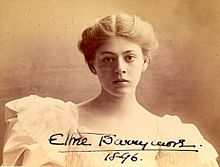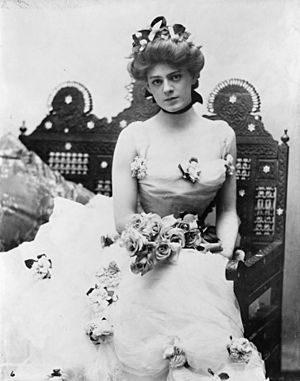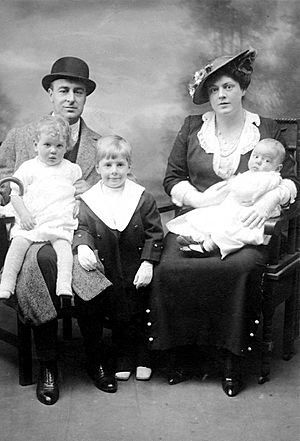Ethel Barrymore facts for kids
Quick facts for kids
Ethel Barrymore
|
|
|---|---|
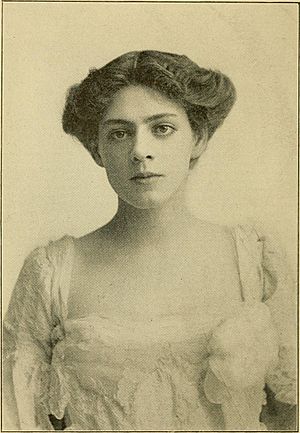
Barrymore in 1896
|
|
| Born |
Ethel Mae Blythe
August 15, 1879 Philadelphia, Pennsylvania, U.S.
|
| Died | June 18, 1959 (aged 79) Los Angeles, California, U.S.
|
| Occupation | Actress |
| Years active | 1895–1957 |
| Spouse(s) |
Russell Griswold Colt
(m. 1909; div. 1923) |
| Children | 3 |
| Parent(s) | Maurice Barrymore Georgiana Drew |
| Family | Barrymore |
| Signature | |
Ethel Barrymore (born Ethel Mae Blythe; August 15, 1879 – June 18, 1959) was a famous American actress. She was part of the well-known Barrymore family of actors. Ethel worked on stage, in movies, and on the radio for over sixty years. People called her "The First Lady of the American Theatre." She was nominated four times for the Academy Award for Best Supporting Actress and won for her role in the movie None but the Lonely Heart (1944).
Contents
Ethel Barrymore's Early Life
Ethel Mae Blythe was born in Philadelphia, Pennsylvania. She was the second child of actors Maurice Barrymore and Georgiana Drew. Her father's real name was Herbert Blythe. Ethel was named after a character in a book her father liked.
She was the sister of famous actors John and Lionel Barrymore. She was also the aunt of actor John Drew Barrymore. Her grand-aunt was actress Drew Barrymore. Her grandmother was Louisa Lane Drew, who managed a theater. Her uncle was the Broadway star John Drew Jr.
Ethel grew up in Philadelphia and went to Catholic schools there. In 1884, her family went to England for two years. Her father had inherited money and wanted to perform in London. Ethel remembered being scared when she first met Oscar Wilde. She later got in trouble for showing her fear. When they returned to the U.S. in 1886, her father took her to her first baseball game. She loved baseball her whole life. She also wanted to be a concert pianist. Her years in England were her happiest because her family was closer there.
Ethel Barrymore's Acting Career
In 1893, Ethel's mother, Georgie, was very sick with tuberculosis. She went to Santa Barbara, California, hoping to get better. Sadly, Georgie died in July 1893, just before her 37th birthday. After her mother died, Ethel and her brother Lionel had to start working as teenagers. Neither of them finished high school. Their younger brother, John, stayed with their grandmother.
Ethel first appeared on Broadway in 1895. It was in a play called The Imprudent Young Couple. Her uncle, John Drew Jr., also starred in it. She acted with him again in 1896 in Rosemary.
In 1897, Ethel went to London with William Gillette for a play. She was about to return home when Henry Irving and Ellen Terry offered her another role. She toured London and, on New Year's Day 1898, acted in Peter the Great. Many men admired Ethel, including Winston Churchill, who asked her to marry him. She said no because she didn't want to be a politician's wife. Winston later married someone who looked a lot like Ethel. They remained friends for life.
After her time in London, Ethel returned to the U.S. Producer Charles Frohman gave her roles in Catherine and His Excellency the Governor. Then, Frohman gave Ethel the role that made her a star: Madame Trentoni in Captain Jinks of the Horse Marines. This play opened in London on February 4, 1901. Her father, Maurice, secretly watched the show. He congratulated her afterward, which was the only time he saw her perform professionally. When the play finished its tour in Boston, Ethel had attracted more audience members than two other famous actresses of her time.
After her success in Captain Jinks, Ethel gave great performances in many plays. In Thomas Raceward's Sunday, she said her most famous line: "That's all there is, there isn't any more." She also played Nora in A Doll's House (1905) and Juliet in Romeo and Juliet (1922).
Supporting Actors' Rights
Ethel Barrymore strongly supported the Actors' Equity Association (AEA). She played a big part in the 1919 actors' strike. During the strike, Ethel and her brother Lionel performed in a show to raise money for AEA. The AEA was created to help actors get a fairer share of profits from plays. It also aimed to help older or sick actors. Ethel's support might have come from seeing her own parents, who were actors, need medical and institutional care. Her support for the strike made some producers angry, and she lost her friendship with producer George M. Cohan.
Life in the 1920s and 1930s
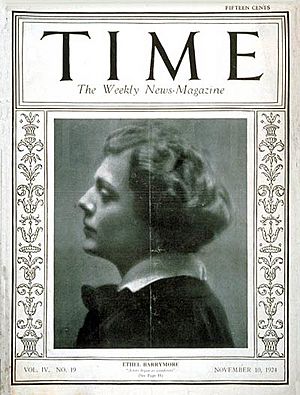
In 1926, Ethel had a huge success in William Somerset Maugham's comedy, The Constant Wife. She played a clever wife whose husband was unfaithful. Maugham admired her greatly. She also starred in Rasputin and the Empress (1932), playing the empress married to Czar Nicholas.
After she became a stage star, Ethel would often tell cheering audiences, "That's all there is—there isn't any more!" This became a popular saying in the 1920s and 1930s. You can find references to it in movies and books from that time.
Ethel Barrymore loved baseball and boxing. However, her love for boxing ended after she saw a very brutal fight in 1919. She promised never to go to another boxing match, though she later watched boxing on television.
In 1928, a theater called the Ethel Barrymore Theatre opened in New York City. It is still open today.
Film and Broadcasting Career
Movies
Ethel Barrymore appeared in her first movie, The Nightingale, in 1914. Her family members were already in movies. Her uncle Sidney Drew and her brother Lionel started in films in 1911. John made his first movie in 1913. Ethel made 15 silent movies between 1914 and 1919. Most of these were made on the East Coast because her Broadway career and children were her priority. Some of her silent films still exist today.
Only two films featured all three Barrymore siblings: Ethel, John, and Lionel. These were National Red Cross Pageant (1917) and Rasputin and the Empress (1932). The first film is now lost.
Ethel Barrymore won an Academy Award for Best Supporting Actress for her role in None but the Lonely Heart (1944). She acted alongside Cary Grant in this film. She was also nominated for Academy Awards for The Spiral Staircase (1946) and The Paradine Case (1947). She received another nomination for the 1949 film Pinky. Her last movie was Johnny Trouble (1957).
Radio and Television
Ethel Barrymore starred in a radio show called Miss Hattie in 1944–1945. She also appeared with Gene Kelly in a radio episode of Suspense in 1949.
In the 1950s, Ethel Barrymore also appeared on television. One famous appearance was with comedian Jimmy Durante in 1951. In 1956, she hosted 14 episodes of a TV series called Ethel Barrymore Theatre.
Ethel Barrymore in Popular Culture
In the movie Somewhere in Time (1980), you can see a photo of Ethel Barrymore. She is wearing a nun's habit from her 1928 play The Kingdom of God. In the musical film Singin' in the Rain (1952), Ethel Barrymore is mentioned as an example of a serious actress. This happens when Gene Kelly teases Debbie Reynolds about what makes a true actor.
Ethel Barrymore's Private Life
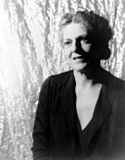
Winston Churchill was one of Ethel Barrymore's many friends in England. It was rumored that Churchill proposed to her in 1900. Ethel does not mention this in her autobiography, but she does include a photo of herself and Churchill in 1899. While touring in England at age 19, people also thought she might marry the Duke of Manchester or actor Gerald du Maurier.
Ethel Barrymore married Russell Griswold Colt (1882–1960) on March 14, 1909. They met through her uncle, John Drew, or her brother, John Barrymore.
Ethel and Russell had three children:
- Samuel "Sammy" Colt (1909–1986), who became a Hollywood agent.
- Ethel Barrymore Colt (1912–1977), an actress and singer.
- John Drew Colt (1913–1975), who also became an actor.
Ethel's marriage to Russell was difficult. They divorced in 1923. Ethel did not ask for money for herself from the divorce. However, she made sure that her children would be financially supported. Ethel Barrymore was a devout Catholic and never remarried after her divorce.
Ethel Barrymore's Death
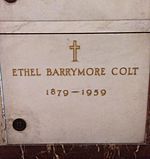
Ethel Barrymore died on June 18, 1959, at her home in Hollywood. She was almost 80 years old and had a heart condition for many years. She was buried at Calvary Cemetery. The Ethel Barrymore Theatre in New York City is named in her honor.
Honors and Legacy
In 1960, Ethel Barrymore received a star on the Hollywood Walk of Fame for her work in movies. Her star is located at 7001 Hollywood Boulevard. Ethel Barrymore is also a member of the American Theater Hall of Fame, along with her brothers, John and Lionel.
See also
 In Spanish: Ethel Barrymore para niños
In Spanish: Ethel Barrymore para niños
- List of actors with Academy Award nominations
- List of covers of Time magazine (1920s) – November 10, 1924



